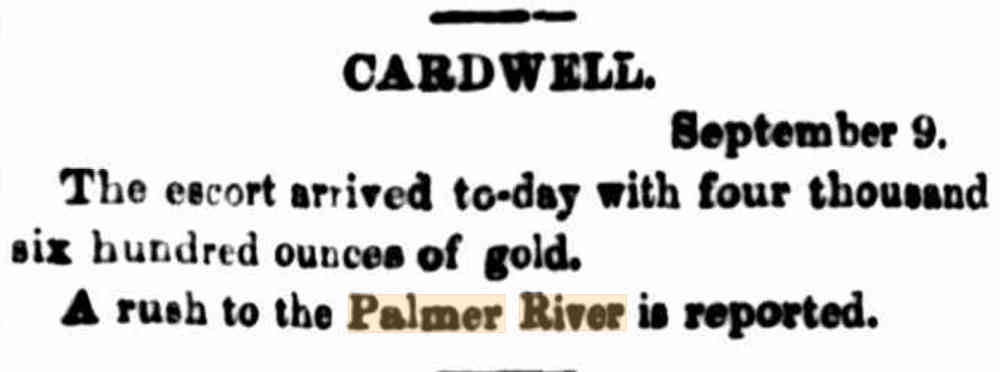

Australian explorer William Hann and geologist Norman Taylor discovered and named the Palmer River in 1872, and reported traces of alluvial gold extending for a distance of around 60 miles along the river's course. By April 1873, prospectors from the the Etheridge goldfield were venturing to the Palmer, and by September a small rush had started from that northern goldfield to the Palmer River.

James Venture Mulligan's party set out from Georgetown, confirmed Hann's reports, and further reported that the gold was plentiful. Mulligan retrieved 102 ounces of gold on his 1873 expedition, and returned in 1874 and recorded:
We may prospect for gold, but when on it will not work for less than I oz. per man per day; less will not pay us for our expense and loss of time; and though a day’s work may result in four or five times that, yet it must be considered exceptional. Up to n ow a few men only have been here, but these last few days men are coming in in crowds; so we will gather our horses and leave today.
Mulligan made public his finds in Queenslander 28th February 1874, then published his expeditionary journal in April 1875 as Guide to the Palmer River and Normanby Gold Fields, North Queensland. This expanded the gold rush to the Palmer, attracting thousands of people to the region. At least 9,000 people arrived on the field in the first two years.

The first diggers faced a harsh tropical environment in a very remote area of Australia. Many miners succumbed to starvation and disease. There were reports of miners being shot and killed by claim-jumpers, and others were shot and robbed of their gold. There were battles with the aborigines, and when the Chinese arrived in great numbers, ethnic conflict ensued. In September 1875, it was estimated that there were 4,000 Europeans and 10,000 Chinese on the field. The Chinese population peaked at 17,000 two years later.
Gambling was an awful curse on the Palmer. Chinamen were fleeced of their money and were then compelled to resort to crime in order to get an existence. We did our best to improve matters, and made several exciting raids on the gambling houses. The black troopers took infinite delight in this sort of work; and it was very funny after a big haul to see the troopers lugging six or eight Chinese in each hand, and holding them by the pigtails.
The alluvial gold of the Palmer River and its tributaries had accumulated over thousands of years. Deposits could be found where one could literally shovel the gold out. Early prospectors rushed to find these lucrative deposits, quickly moving on to new finds once the easy pickings were taken. The Chinese miners worked the deposits left behind by the first wave of prospectors. Townships that sprang up on the field included Palmerville, Maytown, Idatown and Byerstown
Of these, Maytown was the largest. Surveyed in 1875, by the following year Maytown boasted 12 hotels, six stores, three bakers, tobacconists, stationers, and a lemonade factory. The majority of the population serviced by the town was Chinese: in 1882 there were 10 Chinese stores compared to two European stores.

Just to show how easily gold was got on the Palmer, I was in my office one morning when a European miner came in for a Miner's Right. He told me he was going prospecting, and next morning the same man came to me and asked if I would put a bag into my safe for a time. He said, "It's a few specimens I got yesterday in about three hours." He said he was up a gully looking for his horses and found that one of them had kicked a large stone over, disclosing a nest of nuggets. I asked him how much he got, and he replied, "Weigh the lot, sir, please." And I did, and found the lot weighed one hundred and seventy-nine ounces three pennyweights, the smallest piece weighing seventeen pennyweights. The nuggets were lovely to look at, all water worn and of the most fantastic shapes. One beauty was exactly thirteen and a half ounces.
By 1875, the alluvial gold was diminishing and mining activities were shifting to working the reef gold around Maytown. Reef gold is located in quarz reefs and requires hard-rock mining and ore crushing machinery. This proved to be difficult in the remote environment, and by the 1880s, most miners had moved on to other fields.
Today, part of the goldfield is managed by the Department of National Parks as the Palmer Goldfield Regional Park. There are still mining ventures operating on the field, and it is a popular area for independent prospectors and fossickers.
Chinese Miners on the Palmer, Noreen Kirkman, 1986.